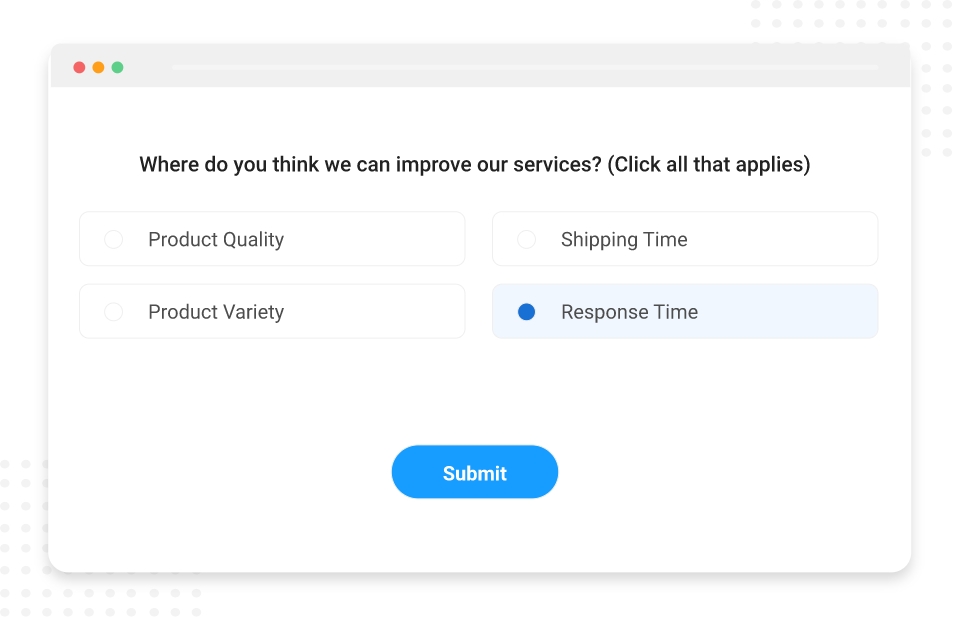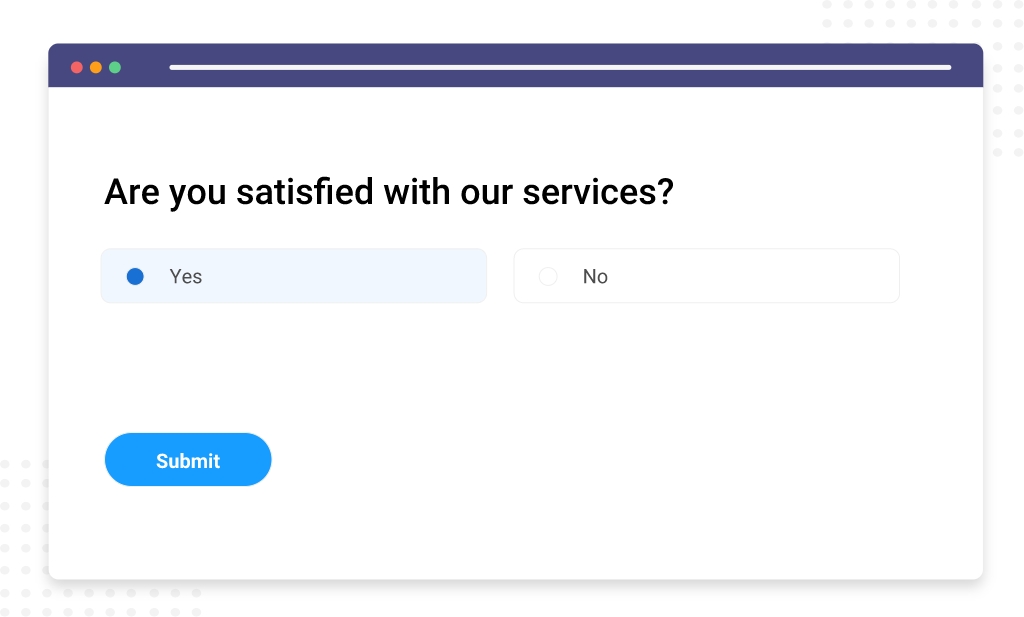
Emma David, a seasoned market research professional, specializes in employee engagement, survey administration, and data management. Her expertise in leveraging data for informed decisions has positively impacted several brands, enhancing their market position.
Learn about Our Editorial Process Market Research Specialist Updated: 30 Aug, 2024
Close ended questions stand out as a powerful tool for gathering clear, concise data. They offer respondents straightforward options, making it easier to analyze and understand the collective voice of your audience. The questions in a close ended survey are direct, offering respondents a set of fixed answers. This simplicity is their strength, providing clear, quantifiable insights that are easy to analyze.
Whether you’re gauging public opinion, customer feedback , or employee engagement, close ended surveys would not only streamline the response process but also enhance the quality of data collected.
In this blog, we’ll explore how to utilize close ended questions effectively, ensuring your surveys are both engaging for participants and invaluable for your decision-making process.
But before that, here is a quick tutorial on how to create a survey with ProProfs Survey Maker:
Watch: How to Create a Survey Using ProProfs Survey Maker
Close ended questions are structured queries that limit respondents to a set of predefined answers, such as “yes” or “no,” multiple choice, or a rating scale. These questions are designed to gather specific, quantitative data , making it easier to analyze and compare responses across a wide audience.
In a way, close ended survey questions are opposite to open ended questions , where respondents can share their thoughts and opinions in-depth.
Due to their brevity and limited response options, these questions usually generate a high survey response rate and rapidly collect large quantities of data.
Read More – Qualitative vs Quantitative data: Difference, Methods & AnalysisClose ended questions can be structured using multiple-choice options, rating scales , drop-down menus, and radio buttons. In this section, we’ll discuss the types of close ended questions along with their examples:
Here, respondents are presented with multiple-choice answer options. It can be further divided into two types:
A. Radio-Choice
In these types of questions, respondents can only choose one answer among the given set of response options.
An example of this type of closed-ended survey question includes:
B. CheckBoxes
In these types of questions, respondents can choose more than one option among the given set of response options. For example,

Researchers use this type of question when they want respondents to rate how they feel about a particular subject, usually on a scale of 1-5.
An example of a rating-scale question for a close ended survey:

Ranking-order questions allow respondents to rank multiple-choice options based on a specific order. They ask the participants to evaluate multiple items in a particular order.
A Likert-scale question helps measure the participant’s opinion or attitude towards a given topic. The Likert scale is basically a five- seven- or nine-point scale used to measure the extent to which respondents agree or disagree with a particular question or statement.
A close ended survey question example for a Likert scale is:
These are the questions that consist of two answer options. It can be “True/ False” questions, “Yes/No” questions, or “Agree/ Disagree” statements. It’s the easiest type of question for survey makers to interpret and respondents to answer.

Let’s discuss 60+ close ended question examples for a survey. You can use them directly or modify them as per your research.
Want to create a close ended questionnaire with the example questions?
Close ended questions are used in surveys to gather specific and relevant information. Understanding when to utilize these questions is essential for collecting actionable and quantitative data.
So let’s look at the possible areas where close ended questions can be used effectively.
Closed-ended questions are most useful when the aim is to gather numerical data. Their structured format provides easily quantifiable responses, facilitating statistical analysis. This data can be efficiently processed and presented using graphs or charts for enhanced comprehension.
Utilizing closed-ended questions enables the segmentation of respondents based on their answers.
For instance, demographic segmentation by age groups such as “under 20,” “20 to 40,” and “over 40” allows for a targeted understanding of distinct preferences and needs within different demographic segments.
Read More – Market Segmentation: Types and BenefitsPeople find it easier to answer surveys with closed-ended questions, and thus, close ended questions tend to elicit higher response rates compared to open-ended questions. Open-ended questions need long answers, which can put people off. This simplicity encourages increased engagement with the survey.
Closed-ended questions ensure uniformity in responses across all respondents. By presenting the same set of response options to each participant, ambiguity and inconsistency are minimized. This standardization streamlines data analysis and interpretation.
The structured format of closed-ended questions facilitates efficient data analysis. Responses can be easily quantified, allowing for straightforward computation of statistics and metrics. This streamlined process enables researchers to derive meaningful insights and actionable conclusions.
You do get many advantages when using closed-ended questions in a survey – hence, the popularity! However, remember that they are not suitable for all types of research; therefore, you should consider the type of data you want to collect before using them.
Let’s see some of the prime benefits of close ended questions:
As beneficial as they are, closed-ended questions aren’t entirely devoid of disadvantages either, such as
No one likes to fill out a survey that takes hours to complete. To collect data efficiently and increase the survey response rate, you need to keep your participant’s attention span in mind.
Some best practices for using closed-ended questions such that their accuracy and usefulness remain in place are given below:
For example, instead of asking, “ Do you like our product?” that is too vague and lacks specificity, try asking, “ How satisfied are you with the ( ______) of our product?”.
This question is clear and specific, focusing on a particular aspect of the product to provide clearer responses.
See this question: “ Do you prefer online or in-store shopping, and why?”. Pretty confusing, right? This question combines two topics (shopping preference and reasons) into one, making it difficult for respondents to provide coherent answers.
Instead, you can ask, “ Do you prefer to shop online or in-store for groceries ?”
This question addresses a single issue (shopping preference) without combining multiple topics, ensuring a clear answer.
A question framed like, “ Don’t you agree that our product is the best on the market?” presumes a positive response and may influence respondents to agree even if they have a different opinion. This is a marked example of a leading or biased question.
A neutral question allows respondents to provide their opinions without being influenced by biased language. An example being, “ How would you rate the quality of our product compared to other options available on the market ?”
For example, “ How satisfied are you with our product? Please explain the reasons behind your satisfaction or dissatisfaction .”
This combination allows respondents to provide additional context or detail beyond the closed-ended response.
We have almost reached the end of this blog and have seen that close ended surveys offer valuable insights when utilized effectively. They provide precise data, ease of analysis, and standardized responses, making them indispensable tools for researchers and organizations alike.
However, it’s essential to acknowledge their limitations, including potential response bias and limited insight. By leveraging the advantages of closed-ended surveys while remaining mindful of their drawbacks, you can enhance the quality of their data collection efforts.
Whether conducting market research, gathering customer feedback, or evaluating employee satisfaction, understanding when and how to employ closed-ended surveys is essential for obtaining actionable insights.
To start gathering in-depth insights in no time, use our free inbuilt survey templates here!
FREE. All Features. FOREVER!
Try our Forever FREE account with all premium features!